
在线博客:http://golang.iswbm.com/
Github:https://github.com/iswbm/GolangCodingTime
---
## 1. 静态类型
所谓的**静态类型**(即 static type),就是变量声明的时候的类型。
```go
var age int // int 是静态类型
var name string // string 也是静态类型
```
它是你在编码时,肉眼可见的类型。
## 2. 动态类型
所谓的 **动态类型**(即 concrete type,也叫具体类型)是 程序运行时系统才能看见的类型。
这是什么意思呢?
我们都知道 **空接口** 可以承接什么问题类型的值,什么 int 呀,string 呀,都可以接收。
比如下面这几行代码
```go
var i interface{}
i = 18
i = "Go编程时光"
```
第一行:我们在给 `i` 声明了 `interface{}` 类型,所以 `i` 的静态类型就是 `interface{}`
第二行:当我们给变量 `i` 赋一个 int 类型的值时,它的静态类型还是 interface{},这是不会变的,但是它的动态类型此时变成了 int 类型。
第三行:当我们给变量 `i` 赋一个 string 类型的值时,它的静态类型还是 interface{},它还是不会变,但是它的动态类型此时又变成了 string 类型。
从以上,可以知道,不管是 `i=18` ,还是 `i="Go编程时光"`,都是当程序运行到这里时,变量的类型,才发生了改变,这就是我们最开始所说的 动态类型是程序运行时系统才能看见的类型。
## 3. 接口组成
每个接口变量,实际上都是由一 pair 对(type 和 data)组合而成,pair 对中记录着实际变量的值和类型。
比如下面这条语句
```go
var age int = 25
```
我们声明了一个 int 类型变量,变量名叫 age ,其值为 25
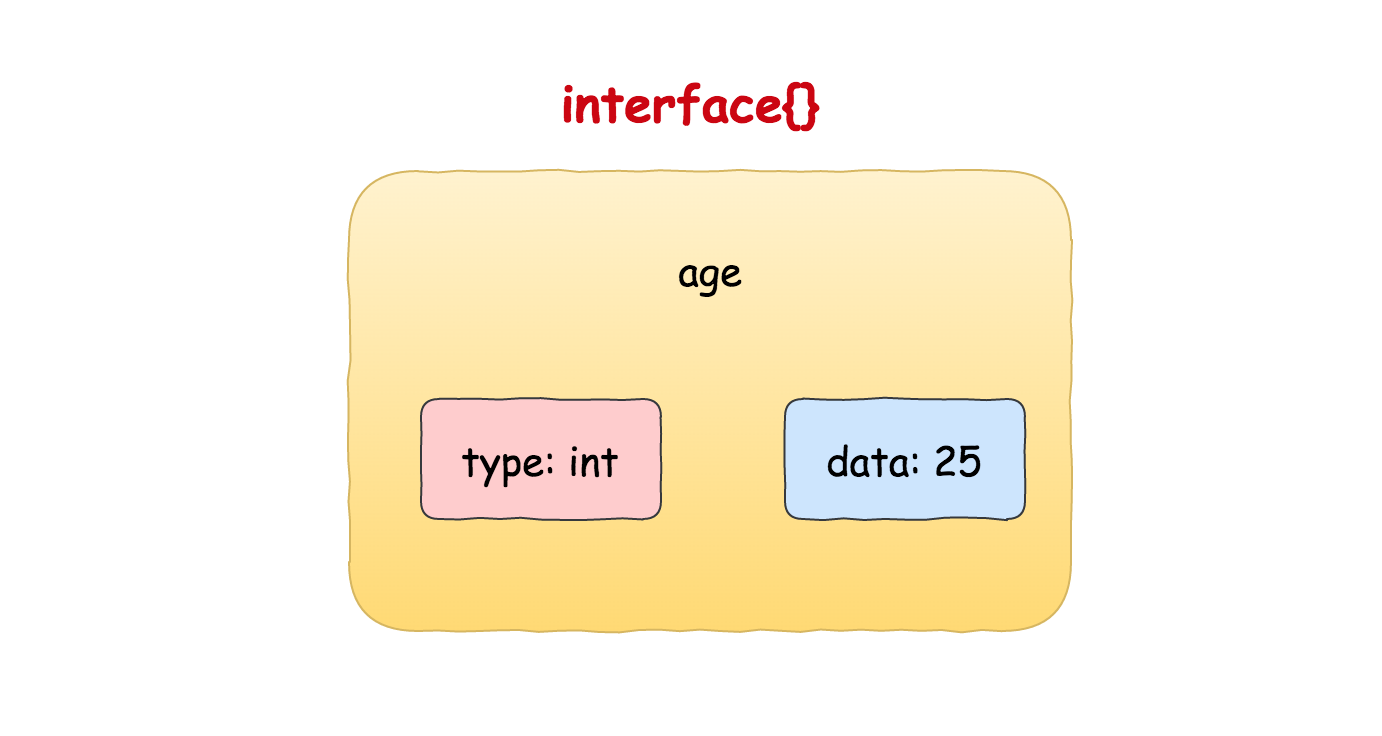
知道了接口的组成后,我们在定义一个变量时,除了使用常规的方法(可参考:[**02. 学习五种变量创建的方法**](http://mp.weixin.qq.com/s?__biz=MzU1NzU1MTM2NA==&mid=2247483669&idx=2&sn=e70a1400c094e981f15b8da552bd8fbf&chksm=fc355b7ecb42d26824985163a3ef0c3567134975637c4efc42161751f54ab10343b485b36e23&scene=21#wechat_redirect))
也可以使用像下面这样的方式
```go
package main
import "fmt"
func main() {
age := (int)(25)
//或者使用 age := (interface{})(25)
fmt.Printf("type: %T, data: %v ", age, age)
}
```
输出如下
```go
type: int, data: 25
```
## 4. 接口细分
根据接口是否包含方法,可以将接口分为 `iface` 和 `eface`。
### iface
第一种:**iface**,表示带有一组方法的接口。
比如
```go
type Phone interface {
call()
}
```
`iface` 的具体结构可用如下一张图来表示
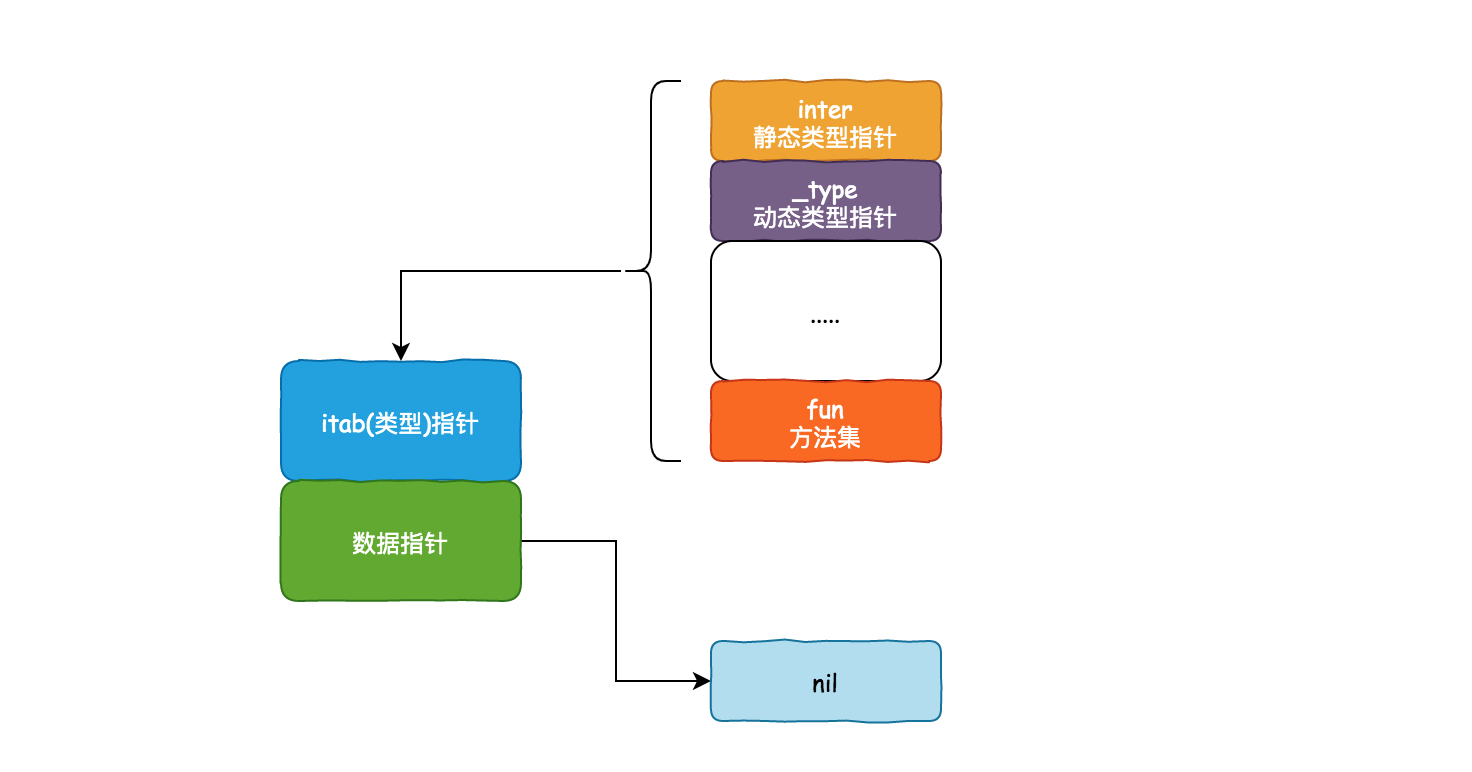
iface 的源码如下:
```go
// runtime/runtime2.go
// 非空接口
type iface struct {
tab *itab
data unsafe.Pointer
}
// 非空接口的类型信息
type itab struct {
inter *interfacetype // 接口定义的类型信息
_type *_type // 接口实际指向值的类型信息
link *itab
bad int32
inhash int32
fun [1]uintptr // 接口方法实现列表,即函数地址列表,按字典序排序
}
// runtime/type.go
// 非空接口类型,接口定义,包路径等。
type interfacetype struct {
typ _type
pkgpath name
mhdr []imethod // 接口方法声明列表,按字典序排序
}
// 接口的方法声明
type imethod struct {
name nameOff // 方法名
ityp typeOff // 描述方法参数返回值等细节
}
```
### eface
第二种:**eface**,表示不带有方法的接口
比如
```go
var i interface{}
```
eface 的源码如下:
```go
// src/runtime/runtime2.go
// 空接口
type eface struct {
_type *_type
data unsafe.Pointer
}
```
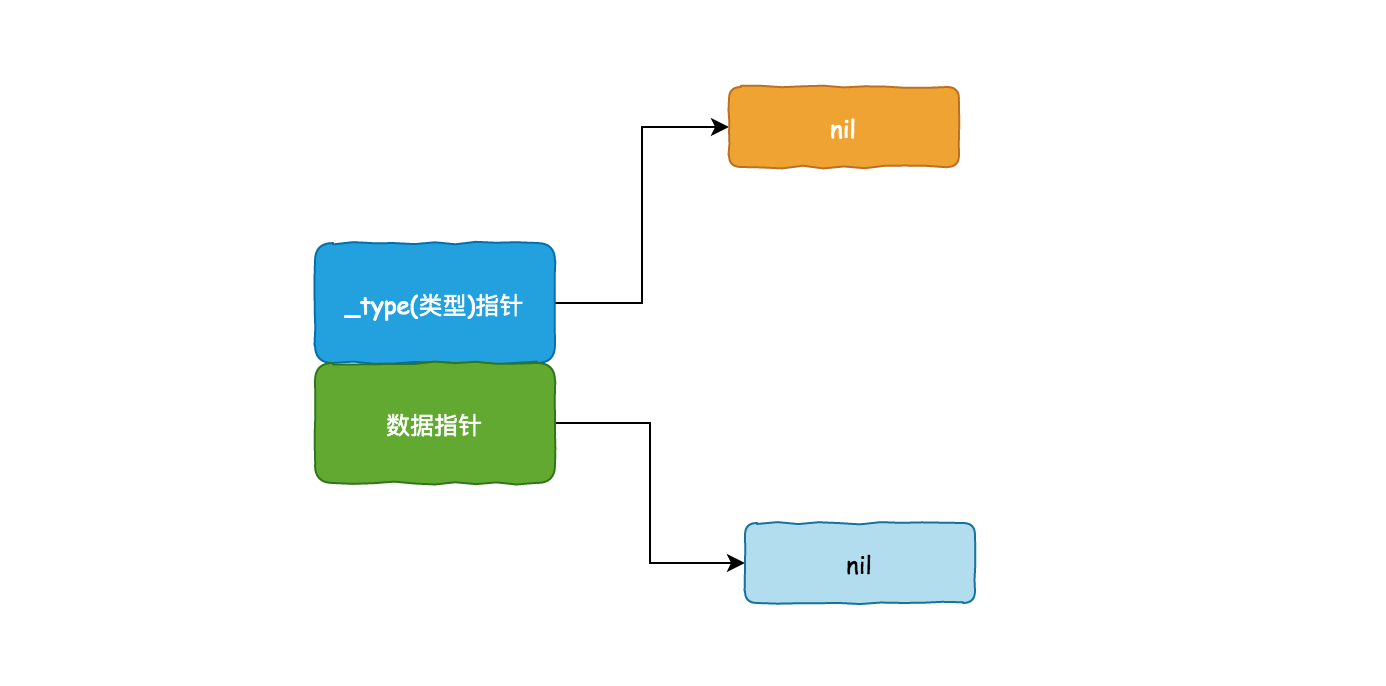
## 5.理解动态类型
前两节,我们知道了什么是动态类型?如何让一个对象具有动态类型?
后两节,我们知道了接口分两种,它们的内部结构各是什么样的?
那最后一节,可以将前面四节的内容结合起来,看看在给一个空接口类型的变量赋值时,接口的内部结构会发生怎样的变化 。
### iface
先来看看 iface,有如下一段代码:
```go
var reader io.Reader
tty, err := os.OpenFile("/dev/tty", os.O_RDWR, 0)
if err != nil {
return nil, err
}
reader = tty
```
第一行代码:var reader io.Reader ,由于 io.Reader 接口包含 Read 方法,所以 io.Reader 是 `iface`,此时 reader 对象的静态类型是 io.Reader,暂无动态类型。

最后一行代码:reader = tty,tty 是一个 `*os.File` 类型的实例,此时reader 对象的静态类型还是 io.Reader,而动态类型变成了 `*os.File`。
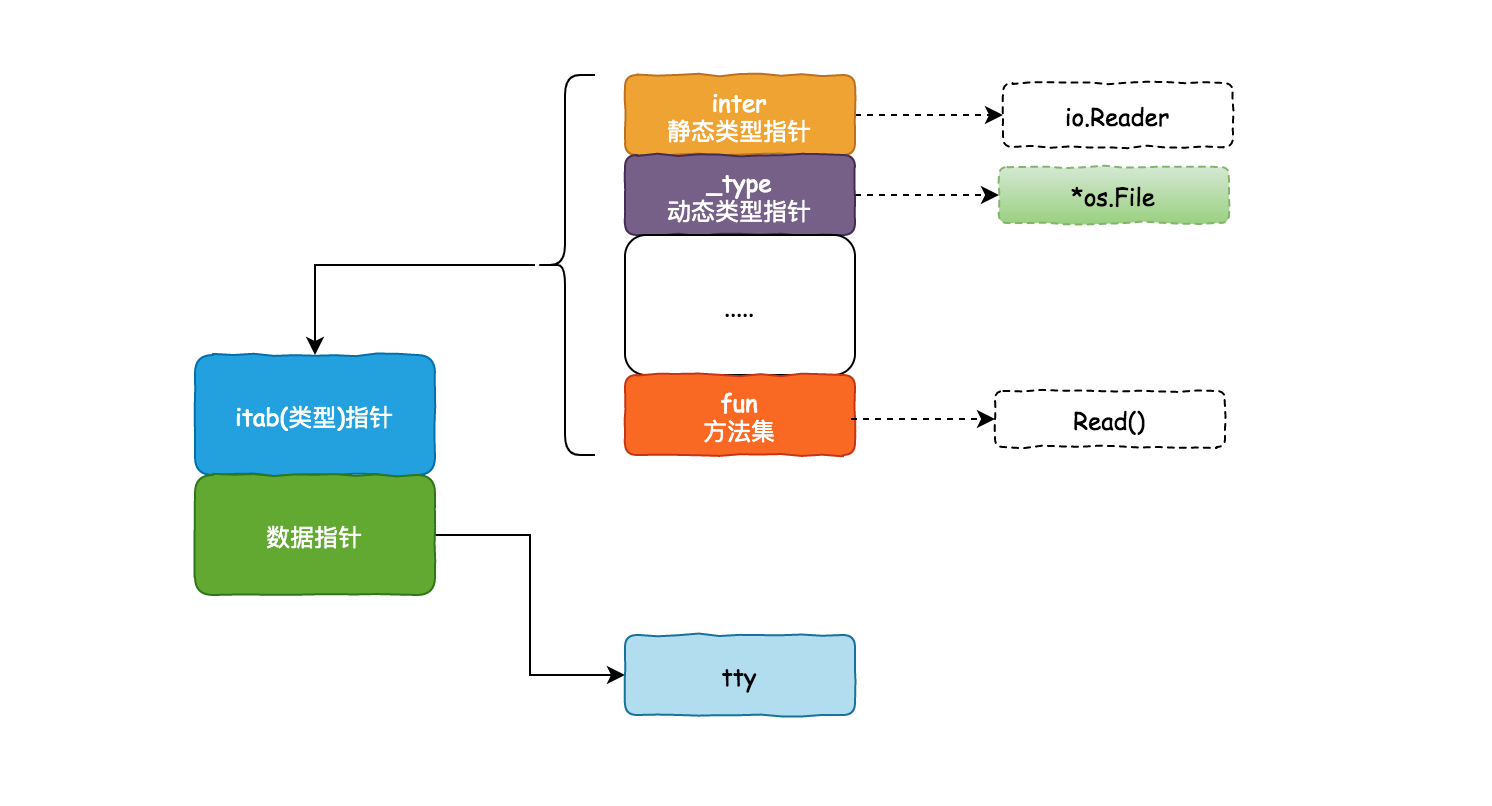
### eface
再来看看 eface,有如下一段代码:
```go
//不带函数的interface
var empty interface{}
tty, err := os.OpenFile("/dev/tty", os.O_RDWR, 0)
if err != nil {
return nil, err
}
empty = tty
```
第一行代码:var empty interface{},由于 `interface{}` 是一个 eface,其只有一个 `_type` 可以存放变量类型,此时 empty 对象的(静态)类型是 nil。
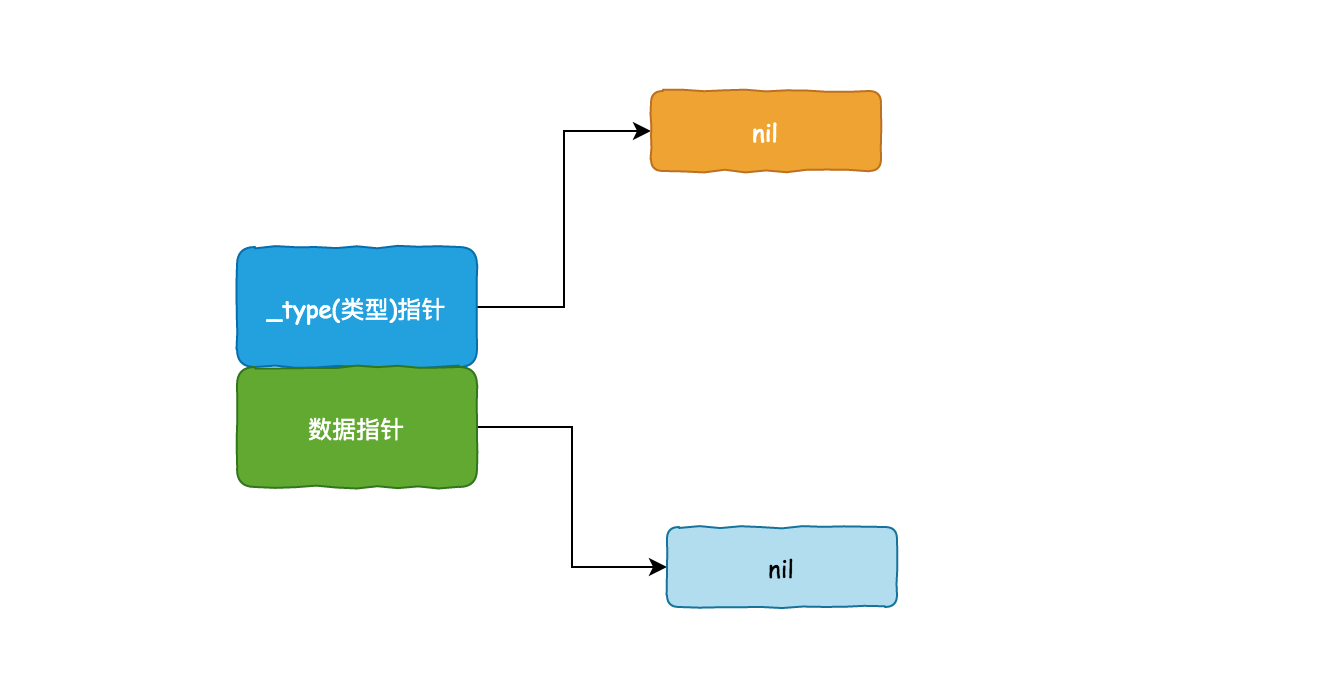
最后一行代码:empty = tty,tty 是一个 `*os.File` 类型的实例,此时 `_type` 变成了 `*os.File`。
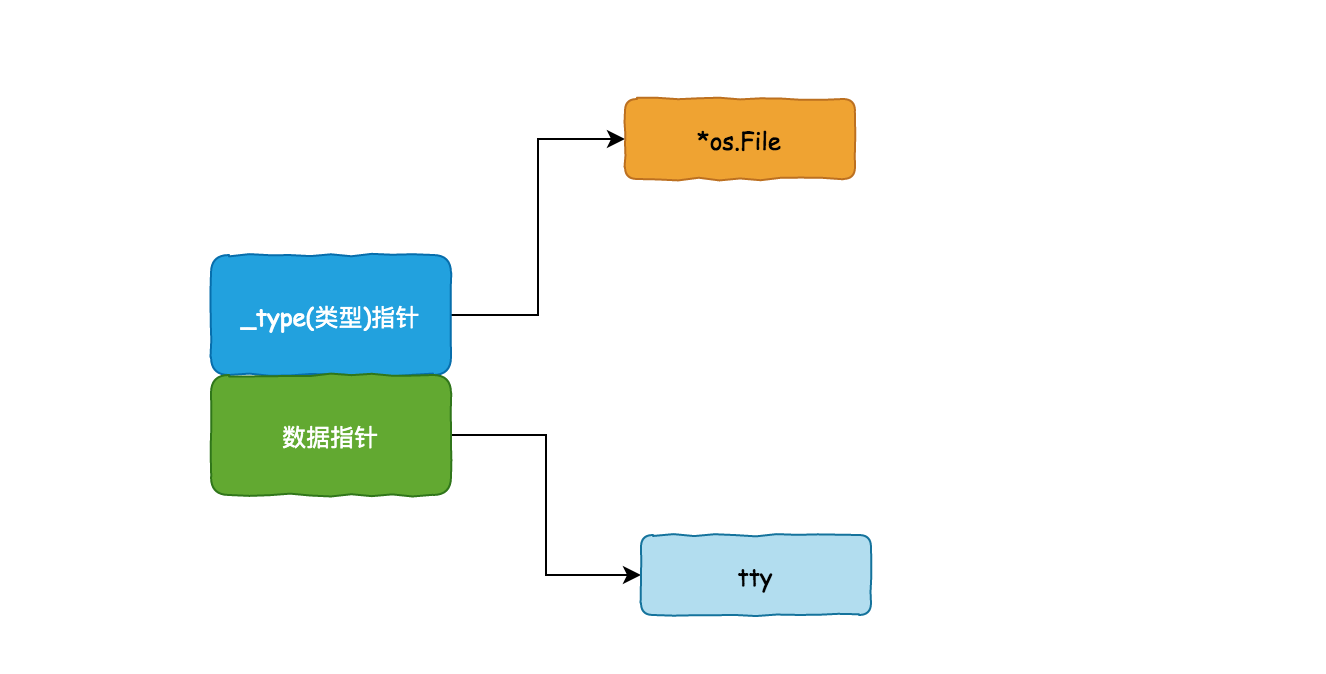
## 6. 反射的必要性
由于动态类型的存在,在一个函数中接收的参数的类型有可能无法预先知晓,此时我们就要对参数进行反射,然后根据不同的类型做不同的处理。
关于 反射 的内容有点多,我将其安排在下一篇。
## 参考文章
- [图解go反射实现原理](https://i6448038.github.io/2020/02/15/golang-reflection/)
## 系列导读
---
[从零学习 Go 语言(01):一文搞定开发环境的搭建](https://studygolang.com/articles/27365)
[从零学习 Go 语言(02):学习五种变量创建的方法](https://studygolang.com/articles/27432)
[从零学习 Go 语言(03):数据类型之整型与浮点型](https://studygolang.com/articles/27440)
[从零学习 Go 语言(04):byte、rune与字符串](https://studygolang.com/articles/27463)
[从零学习 Go 语言(05):数据类型之数组与切片](https://studygolang.com/articles/27508)
[从零学习 Go 语言(06):数据类型之字典与布尔类型](https://studygolang.com/articles/27563)
[从零学习 Go 语言(07):数据类型之指针](https://studygolang.com/articles/27585)
[从零学习 Go 语言(08):流程控制之if-else](https://studygolang.com/articles/27613)
[从零学习 Go 语言(09):流程控制之switch-case](https://studygolang.com/articles/27660)
[从零学习 Go 语言(10):流程控制之for 循环](https://studygolang.com/articles/28120)
[从零学习 Go 语言(11):goto 无条件跳转](https://studygolang.com/articles/28472)
[从零学习 Go 语言(12):流程控制之defer 延迟语句](https://studygolang.com/articles/28515)
[从零学习 Go 语言(13):异常机制 panic 和 recover](https://studygolang.com/articles/28519)
[从零学习 Go 语言(14):Go 语言中的类型断言是什么?](https://studygolang.com/articles/29305)
[从零学习 Go 语言(15):学习 Go 语言的结构体与继承](https://studygolang.com/articles/29306)
[从零学习 Go 语言(17):Go 语言中的 make 和 new 有什么区别?](https://studygolang.com/articles/29315)
[从零学习 Go 语言(18):Go 语言中的 语句块与作用域](https://studygolang.com/articles/29365)
[从零学习 Go 语言(19):Go Modules 前世今生及入门使用](https://studygolang.com/articles/29371)
[从零学习 Go 语言(20):关于包导入必学的 8 个知识点](https://studygolang.com/articles/29404)
[从零学习 Go 语言(21):一文了解 Go语言中编码规范](https://studygolang.com/articles/29477)
[从零学习 Go 语言(22):Go 语言中如何开源自己写的包给别人用?](https://studygolang.com/articles/29609)
[从零学习 Go 语言(23):一篇文章搞懂 Go 语言的函数](https://studygolang.com/articles/29628)
[从零学习 Go 语言(24):理解 Go 语言中的 goroutine](https://studygolang.com/articles/29641)
[从零学习 Go 语言(25):详解信道/通道](https://studygolang.com/articles/29704)
[从零学习 Go 语言(26):通道死锁经典错误案例详解](https://studygolang.com/articles/29756)
[从零学习 Go 语言(27):学习 Go 协程中的 WaitGroup](https://studygolang.com/articles/29783)
[从零学习 Go 语言(28):学习 Go 协程中的互斥锁和读写锁](https://studygolang.com/articles/29838)
[从零学习 Go 语言(29):Go 语言中的 select 用法](https://studygolang.com/articles/29852)
[从零学习 Go 语言(30):如何使用 GDB 调试 Go 程序?](https://studygolang.com/articles/29867)
[从零学习 Go 语言(31):Go 语言里的空接口](https://studygolang.com/articles/29885)
[从零学习 Go 语言(32):理解 Go 语言中的 Context](https://studygolang.com/articles/29900)
[从零学习 Go 语言(33):如何手动实现一个协程池?](https://studygolang.com/articles/29943)
---

有疑问加站长微信联系(非本文作者))





